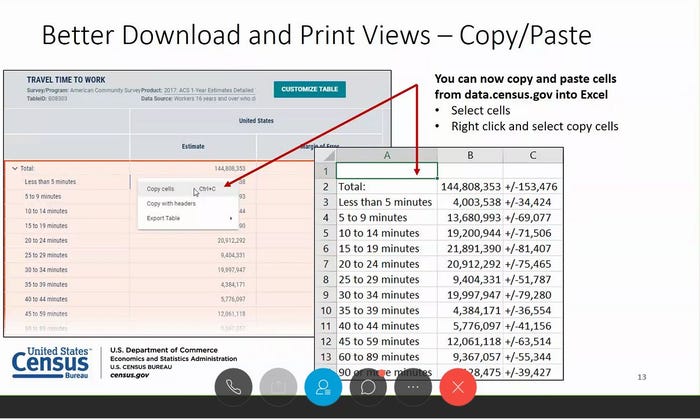Data Gems, Website Updates Make Census Data Easier to Use
Updates include a streamlined user interface, natural language advanced search, data consolidation and map labeling.
August 27, 2019

The U.S. Census Bureau has released more updates to its data.census.gov website to make visualizing census data easier.
 Topping the list is a natural language-based advanced search bar that helps users quickly and easily explore census data and all digital contents, according to their specific interests. Data Gems, a series of short video tutorials, help users visualize data and do other data tasks as well to better understand Census Data and concepts. These updates and video aids will help business users augment data inputs to their self-service business intelligence (BI) and other apps.
Topping the list is a natural language-based advanced search bar that helps users quickly and easily explore census data and all digital contents, according to their specific interests. Data Gems, a series of short video tutorials, help users visualize data and do other data tasks as well to better understand Census Data and concepts. These updates and video aids will help business users augment data inputs to their self-service business intelligence (BI) and other apps.
The U.S. Census Bureau also offers free workshops and training for a variety of organizations, including security providers, to help them develop business plans and use cases, support grant proposals and research projects, develop apps, and innovate or design urban development plans and services.
Indeed, the economic and demographic data the U.S. Census bureau collects and provides has nearly endless business uses. The data is also unique to this one provider. Organizations interested in taking advantage of the free workshop and training sessions should contact the U.S. Census Bureau via email: [email protected].
However, training needs are likely to be ongoing as the site is constantly changing at the moment.
“As a developing site, we’re developing in two-month increments. And while you are actively using the site, and we have new data releases, we understand that this may be difficult because it is an ever-changing site,” said KaNin Reese, chief of the dissemination outreach branch at the U.S. Census Bureau
“But soon, things won’t change as much as we finalize this basic functionality and start working on more advanced needs,” Reese added.
There will also be a free webinar, Sept. 5, on the overall navigation and functionality of data.census.gov. Meanwhile, here are some of the highlights from the August 2019 incremental updates:
The natural language-based advanced search bar is a strong step toward the end goal of integrating the new platform and data releases previewed now on the Census.gov platform with Census.gov so that all data is searchable from one place. “Our data user community told us that people are unable to find the data that they’re looking for on census.gov. And mostly because our data resides in various tools that we have created to release data in different ways, like maps and tables and data visualizations and applications,” said Reese.
Tool integration is also underway. “We’re working to take the best of these tools and apply that functionality to the platform so that all applicable data can have these functionalities all accessible through the search bar,” said Reese.
Now there’s greater access to the Census API. The Bureau is moving away from American FactFinder (AFF) dissemination system to a far more flexible API to make it easier for users to get the precise data points they need, and to pull data and visualizations into their own apps and dashboards. “The API allows for cells of data to be pulled individually, as a table, or as a group of variables, where AFF was solely table-based,” explained Reese. “So, for example, when someone searched for a poverty rate, AFF returned a several hundred-line table. The API allows for that one single poverty estimate to be returned, as well as the table, as well as across geographies and so on. The API is the heart of this platform.”
More census is available, but not all of it. “Not all data are available so that’s the first thing to be mindful of. So please, periodically look at what data are available, so you don’t inadvertently try to access data that aren’t available,” Reese advised. After all data have been migrated, AFF will be shut down.
The user interface (UI) is streamlined. From the search bar and table customizations, to improved download and print views, and mapping improvements, everything is streamlined and performs better and with more efficiency.
Read more about:
MSPsAbout the Author(s)
You May Also Like


